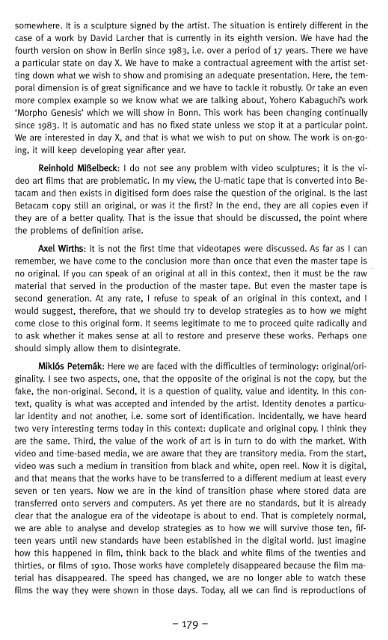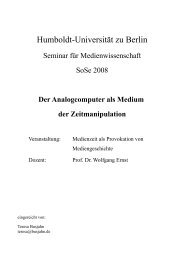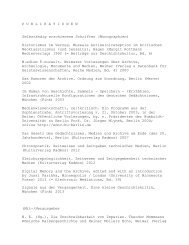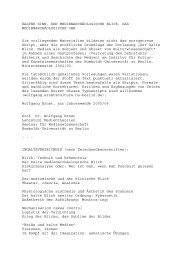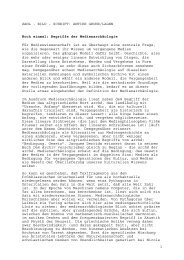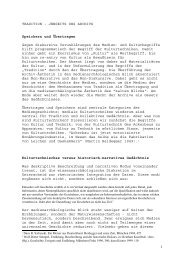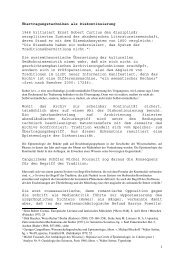Download - Medienwissenschaft
Download - Medienwissenschaft
Download - Medienwissenschaft
You also want an ePaper? Increase the reach of your titles
YUMPU automatically turns print PDFs into web optimized ePapers that Google loves.
somewhere. It is a sculpture signed by the artist. The situation is entirely different in the<br />
case of a work by David Larcher that is currently in its eighth version. We have had the<br />
fourth version on show in Berlin since 1983, i.e. over a period of 17 years. There we have<br />
a particular state on day X. We have to make a contractual agreement with the artist setting<br />
down what we wish to show and promising an adequate presentation. Here, the temporal<br />
dimension is of great significance and we have to tackle it robustly. Or take an even<br />
more complex example so we know what we are talking about, Yohero Kabaguchi's work<br />
'Morpho Genesis' which we will show in Bonn. This work has been changing continually<br />
since 1983. It is automatic and has no fixed state unless we stop it at a particular point.<br />
We are interested in day X, and that is what we wish to put on show. The work is on-going,<br />
it will keep developing year after year.<br />
Reinhold Mißelbeck: I do not see any problem with video sculptures; it is the video<br />
art films that are problematic. In my view, the U-matic tape that is converted into Betacam<br />
and then exists in digitised form does raise the question of the original. Is the last<br />
Betacam copy still an original, or was it the first? In the end, they are all copies even if<br />
they are of a better quality. That is the issue that should be discussed, the point where<br />
the problems of definition arise.<br />
Axel Wirths: It is not the first time that videotapes were discussed. As far as I can<br />
remember, we have come to the conclusion more than once that even the master tape is<br />
no original. If you can speak of an original at all in this context, then it must be the raw<br />
material that served in the production of the master tape. But even the master tape is<br />
second generation. At any rate, I refuse to speak of an original in this context, and I<br />
would suggest, therefore, that we should try to develop strategies as to how we might<br />
come close to this original form. It seems legitimate to me to proceed quite radically and<br />
to ask whether it makes sense at all to restore and preserve these works. Perhaps one<br />
should simply allow them to disintegrate.<br />
Miklos Peternäk: Here we are faced with the difficulties of terminology: original/originality.<br />
I see two aspects, one, that the opposite of the original is not the copy, but the<br />
fake, the non-original. Second, it is a question of quality, value and identity. In this context,<br />
quality is what was accepted and intended by the artist. Identity denotes a particular<br />
identity and not another, i.e. some sort of identification. Incidentally, we have heard<br />
two very interesting terms today in this context: duplicate and original copy. I think they<br />
are the same. Third, the value of the work of art is in turn to do with the market. With<br />
video and time-based media, we are aware that they are transitory media. From the start,<br />
video was such a medium in transition from black and white, open reel. Now it is digital,<br />
and that means that the works have to be transferred to a different medium at least every<br />
seven or ten years. Now we are in the kind of transition phase where stored data are<br />
transferred onto servers and computers. As yet there are no standards, but it is already<br />
clear that the analogue era of the videotape is about to end. That is completely normal,<br />
we are able to analyse and develop strategies as to how we will survive those ten, fifteen<br />
years until new standards have been established in the digital world. Just imagine<br />
how this happened in film, think back to the black and white films of the twenties and<br />
thirties, or films of 1910. Those works have completely disappeared because the film material<br />
has disappeared. The speed has changed, we are no longer able to watch these<br />
films the way they were shown in those days. Today, all we can find is reproductions of<br />
-179-


